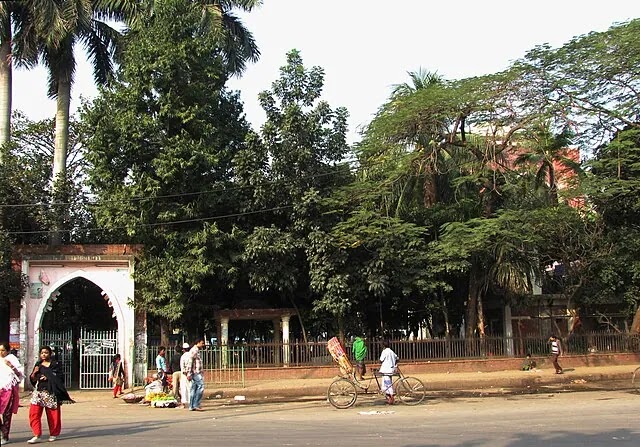Bahadur Shah Park is a historical site. The location of it is in Laxmibazar near Sadarghat in Old Dhaka, the capital of Bangladesh. They have now established a park here.

This place has witnessed many historical events. This site is oval and surrounded by iron railings. It has two main gates on the east and west sides.
More Information About Bahadur Shah Park
Inside this site, there is a paved road along the railings. This place is in the beginning point of Laxmibazar. It is at the entrance to the Sadarghat area.
This area is one of the main river ports of the capital of Bangladesh, Dhaka. Seven roads converge around the park. Many consider it one of the most notable areas of old Dhaka.
Several schools, colleges, and universities are there. Additionally, the area includes notable government buildings. St Thomas Church is on the north side of the park.
Dhaka’s first water supply tank is also on the north side. Kabi Nazrul Government College and Islamia High School are there too.
Government Muslim School, one of the oldest schools in Dhaka, is on the east side. Jagannath University is on the southwest corner.
The judge court of Dhaka is just northwest of this site. The road in this area is the main road from some valuable areas of Dhaka, like Bangla Bazar, to the new site of Dhaka.
At the end of the 18th century, there was a billiard club for the Armenians of Dhaka. Which the locals named Antaghar. The locals called the billiard ball anta.

That is where the word “Antaghar” comes from. Adjacent to the clubhouse was a ground known as Antaghar Maidan.
In 1858, Queen Victoria took over the rule of India. After this, the Commissioner of Dhaka Division read out a declaration. Since then, people have named this place Victoria Park.
People knew the park as Victoria Park until 1957. After the 1857 sepoy mutiny, the British rulers hanged many revolutionary sepoys.
They had a farcical trial. Then, to scare the people, they hung the bodies of the sepoys on the branches of various trees in this field.
In 1957, the authority built a memorial to mark the centenary of the Mutiny. They also renamed the park as Bahadur Shah Park.
The Sepoy Mutiny took place to end the British rule and restore the rule of the Mughal Emperor Bahadur Shah II. They renamed it “Bahadur Shah Park” after him.
History
The British bought it in the first half of the 19th century. They made it a park with iron surrounding it and placed four spectacular cannons at its corners.
They demolished the place soon after it became dilapidated. Nawab Abdul Ghani initiated the construction of a Maidan in its place.
Many Armenians still lived around the area of the Bahadur Shah Park. Even in 1840, it was a garden around a space between several streets.
Nawab Abdul Gani and Nawab Ahsan Ullah of Dhaka were patrons of this clubhouse. In the club, besides billiards, the English played tennis and badminton and chatted.
They also organized party functions here. According to the history of Dhaka Club and old documents, Dhaka Club had one acre of land near Antaghar Maidan.
According to former employees, Dhaka Club used to pay rent for three acres. The authority of the club did it for this area till 1952.
As the power and influence of the Nawabs of Dhaka waned in the 1920s, their donations to the club dwindled. The British moved the Dhaka Club to the Shahbagh area.
They did this to hold horse races at the Race Course Maidan in Dhaka and other purposes. This Maidan gained fame in 1857.
On November 22, 1857, British marines launched an attack. They did this to disarm the native troops stationed at Lalbagh fort in Dhaka.
But when the sepoys interfered, the war broke out. Soldiers were wounded, and the British captured the deserters.
They were convicted in a brief court-martial and executed. After the trial, British authority brought 11 sepoys to Antaghar Maidan and publicly hanged them.
The dead bodies are hung from the trees here for many days to instill fear among the local people. After this event, residents felt afraid to walk around this site for many days.
After suppressing the mutiny, the British built a monument in the Antaghar Maidan. They did this to commemorate their soldiers.
The four British cannons mark the boundary. British placed the cannons at the four corners of the Armenian Club House.
Later, the British removed and placed the cannons around the park. Nawab Abdul Ghani’s contribution was in the development of this park.

After his grandson Khwaja Hafizullah died, his friends raised money to remember him. In 1884, they put a memorial plaque here.
In 1957, the ‘Dhaka Improvement Trust’ (DIT) constructed a memorial at the site. They did this to mark the 100th anniversary of the Sepoy Mutiny.